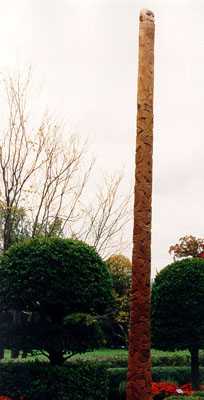Rick Bartow
| Rick Bartow | |
|---|---|
 Cedar Mill Pole, 1997 | |
| Born |
Rick Bartow 1946 Newport, Oregon |
| Nationality | Wiyot and Yurok |
| Education | Western Oregon University |
| Known for | sculpture, painting, printmaking |
Rick Bartow (born 1946 in Newport, Oregon) is a Native American artist of Wiyot and Yurok (Native American groups indigenous to Humboldt County, California) heritage. He works in sculpture, print, etching, monotype, ceramics, mixed media, and painting.[1]
Early life
Rick Elmer Bartow was born in Newport, Oregon in December 1946 to Mabel and Richard Bartow. His father's family was of Yurok Indian descent of northwestern California. In Oregon, the family developed close ties with the local Siletz Indian community. When Rick was five, his father died. His non-Indian mother then married Andrew Mekemson, whom Bartow considers a beloved second father. He became interested in art at an early age, encouraged by his aunt Amy Bartow, who was studying art and art education at the University of Washington. His love for art continued through high school and extended to music when he took up the guitar and bongos.[2]
Personal life
He attended Western Oregon University and graduated in 1969 with a degree in secondary art education. In 1969, he was drafted into the army and sent to Vietnam. He served in the Vietnam war from 1969 to 1971 as a teletype operator and as a musician in a military hospital, for which he was awarded the Bronze Star.[3][4]
Art career
His work can be found in several museum collections including the Peabody Essex Museum[5] in Salem, Massachusetts; Eiteljorg Museum of American Indians and Western Art in Indianapolis, Indiana; the National Museum of the American Indian in Washington, DC; the Hallie Ford Museum of Art in Salem, Oregon; the Heard Museum in Phoenix, Arizona; the de Saisset Museum;[6] and the Portland Art Museum.[7] In 2003 his works were exhibited at the George Gustav Heye Center, a branch of the National Museum of the American Indian in New York City.[8]
His carving The Cedar Mill Pole was displayed in the Jacqueline Kennedy Garden at the White House in 1997; it had been designated one of the most highly regarded Native American public sculptures in the country.[9][10] The pole was partially inspired by Bartow's work with the Māori artist John Bevan Ford. Presented as a gift to the Portland, Oregon metropolitan community from Oregon's Washington County and the Oregon College of Art and Craft, it was intended to help heal the controversy that surrounded an urban development project. The 26-foot-tall carving was created using one of the giant cedars that were removed for a road project.[11]
Bartow's monumental cedar sculptures "We Were Always Here" were commissioned by the Smithsonian National Museum, and sit on the Washington DC Mall, visually across from the Washington Monument, at the entrance to the National Museum of Indian Art. Dedicated on the autumn equinox, Friday, Sept. 21,2012 at 5:30 p.m., the towering works represent the pinnacle of Bartow's accomplishments.[12]
As influences, Bartow cites Marc Chagall, Francis Bacon, Odilon Redon, and Horst Janssen, in addition to his Native American heritage and his work with the Māori. These artists also worked expressionistically with human and animal forms.[3]
Bartow is also a musician and singer with his own band; he plays the guitar.[1][3]
Notes
- ↑ 1.0 1.1 Suzanne J. Crawford, Dennis F. Kelley (2005). American Indian Religious Traditions: An Encyclopedia. ABC-CLIO. p. 43. ISBN 1-57607-517-6.
- ↑
- Dobkins, Rebecca J. (2002). Rick Bartow: My Eye. Seattle: University of Washington Press.
- ↑ 3.0 3.1 3.2 "Tears and Rain". Oregon Historical Quarterly. Retrieved 2008-04-27.
- ↑ artandwriting.org
- ↑ Peabody Essex Museum Collection
- ↑ scu.edu
- ↑ portlandartmuseum
- ↑ "Rick Bartow". National Public Radio. 2003-04-18. Retrieved 2008-04-27.
- ↑ "The Arts Subject of Public Conversation at the Museum of TTU". Texas Tech University. 2003-09-10. Retrieved 2008-04-27.
- ↑ "Washington County, Oregon Updates". Washington County (Oregon). 1997-11-24. Retrieved 2008-04-27.
- ↑ "The Cedar Mill Pole - R.E. Bartow". The White House. Retrieved 2008-04-27.
- ↑ http://www.smithsonianmag.com/smithsonian-institution/a-pair-of-monumental-sculptures-makes-its-way-to-american-indian-museum-26023025/?no-ist
External links
- Rick Bartow, Vision Project, by Gail Tremblay
- A Time of Visions – Interview with Larry Abbott
- Art in America review of Salem, Oregon exhibition
- Art in America review of San Diego exhibition
|